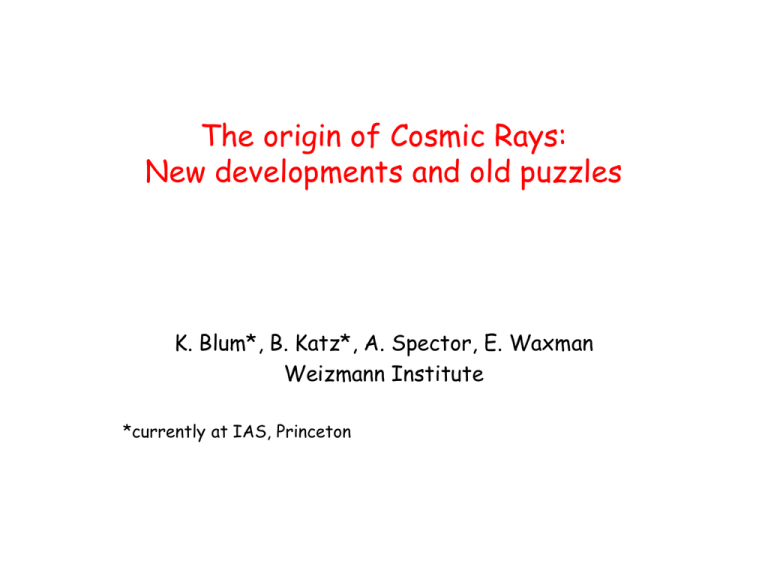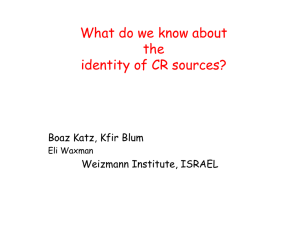pptx
advertisement

The origin of Cosmic Rays:
New developments and old puzzles
K. Blum*, B. Katz*, A. Spector, E. Waxman
Weizmann Institute
*currently at IAS, Princeton
The cosmic ray spectrum
[From Helder et al., SSR 12]
log [dJ/dE]
E-2.7
Galactic
Protons
UHE
X-Galactic
E-3
Source: Supernovae(?)
Heavy Nuclei
Source?
Light Nuclei?
Lighter
Source?
1
106
1010
Cosmic-ray E [GeV]
[Blandford & Eichler, Phys. Rep. 87;
Axford, ApJS 94;
Nagano & Watson, Rev. Mod. Phys. 00;
Lemoine, J. Phys. 13]
The cosmic ray generation spectrum
UHE
(>109.5 GeV=101.5 EeV)
UHE: Composition
Auger 2010
[Wilk & Wlodarczyk 10]*
HiRes 2010 (& TA 2011)
HiRes 2005
[*Possible acceptable solution?, Auger collaboration 13]
UHE: Anisotropy & Composition
Biased
(rsource~r
rgal>r
)
gal for
CR intensity
map
(rsource
~rgal
gal)
Galaxy density integrated to 75Mpc
[Kashti & EW 08]
[EW, Fisher & Piran 97]
• Anisotropy @ 98% CL; Consistent with LSS
[Kotera & Lemoine 08; Abraham et al. 08… Foteini et al. 11]
• Anisotropy of Z at 1019.7eV implies
Stronger aniso. signal (due to p) at (1019.7/Z) eV
[since: Acceleration of Z(>>1) to E ~ Acceleration of p to E/Z,
p(E/Z) propagation = Z(E) propagation,
np >= nZ at the source.]
Not observed No high Z at 1019.7eV
[Lemoine & EW 09]
UHE: Flux & Generation Spectrum
• e2(dN/de)Observed=e2(dQ/de) teff.
(teff. : p + gCMB N + p)
Assume: p, dQ/de~(1+z)me-a
log(e2dQ/de) [erg/Mpc2 yr]
cteff [Mpc]
GZK (CMB)
suppression
[Katz & EW 09]
• >1019.3eV: consistent with
protons, e2(dQ/de) =0.5(+-0.2) x 1044 erg/Mpc3 yr + GZK
[EW 1995; Bahcall & EW 03]
Intermediate E
(106 GeV=1 PeV < E < 101.5 EeV)
HE n: UHECR bound
• p+gN+p
p0 2g ; p+ e+ + ne + nm + nm
Identify UHECR sources
Study BH accretion/acceleration physics
• For all known sources, tgp<=1:
e 2 dQ / de
GeV
44
2
3
10 erg/Mpc yr cm s sr
f ( z ) 1, (1 z ) 3
djn
en
WB 10 8
den
2
1, 5 for
• If X-G p’s:
djn
en
(1019 eV) WB
den
[EW & Bahcall 99;
Bahcall & EW 01]
2
Identify primaries, determine f(z)
[Berezinsky & Zatsepin 69]
Bound implications: n experiments
Fermi
2 flavors,
e 2 dQ / de
44
3
10 erg/Mpc yr
0.5
IceCube (preliminary) detection
• 28 events, compared to 12 expected, above 50TeV; ~4s
(cutoff at 2PeV?)
• 1/E2 spectrum, 4x10-8GeV/cm2s sr
• Consistent with ne:nm:nt=1:1:1
• Consistent with isotropy
[N. Whitehorn, IC collaboration, IPA 2013]
IceCube (preliminary) detection
2 flavors,
e 2 dQ / de
44
3
10 erg/Mpc yr
0.5
IceCube’s detection: Some implications
Isotropic, 1:1:1 flavor ratio,
E2n~4x10-8GeV/cm2s sr~E2WB
@ 50TeV<E<2PeV
• Unlikely Galactic: E2g~10-7(E0.1TeV)-0.7GeV/cm2s sr [Fermi]
~10-9(E0.1PeV)-0.7GeV/cm2s sr
• XG distribution of sources,
e2(dQ/de) >=0.5x 1044 erg/Mpc3 yr @ 106GeV< E <109GeV
• p, e2(dQ/de)PeV-EeV~ e2(dQ/de) >10EeV, tgp(pp)>~1
Or:
e2(dQ/de)PeV-EeV>> e2(dQ/de) >10EeV, tgp(pp)<<1 & Coincidence
Low E
(1GeV < E < 1TeV)
Estimating the G-CR production rate
• CR production in the Galactic disk:
1 dQCR
2 dn
e
f conf. ,
de c dA
sec
e
3
f conf.
4 10
disk
10Z GeV
0.5
e
sec r ISM ct conf. 8.7
10Z GeV
sec (e / Z )
nsec (e ) nprim. s eff. n p ,ISM ctconf. nprim. s eff.
mp
disk 2 10 3 g/cm 2 ,
0.5
g/cm 2
• Assuming CR production ~ SFR ~ SN rate, and using
dN SN
dn
e
10 4 / kpc 2 yr, n SN 5 10 5 / Mpc 3 yr, e 2
0.1
dA
de
10Z GeV
we have
e
2 dQCR
44
erg / Mpc 3 yr, 0.1 - 0.2
e
2 10
de
10Z GeV
0.7
eV
cm 3
Galactic CR propagation models?
• For all secondaries:
ni ,sec ( E ) s~i ,sec sec ( E / Z )
p/ p
• For positrons:
n s~ sec ( E / Z ) f ,rad
At ~20GeV: frad~0.3~f10Be
[Katz, Blum, Morag & EW 10; Blum Katz & EW 13]
10 GeV
e /(e e )
f rad
100 GeV
-
• Predictions for e+ & p consistent
with PAMELA & AMS observations.
• Positron anomalies?
- Due to assumptions adopted RE CR
propagation.
- Reflect the absence of a basic
principles model.
Primary e+ sources
DM annihilation [Hooper et al. 09]
Pulsars [Kashiyama et al. 11]
The cosmic ray generation spectrum
Galactic CRs
(+ CRs~SFR)
XG n’s
XG CRs
Universal generation spectrum: Implications
• Natural: All CRs produced in galaxies,
Rate ~ SFR
[Loeb & EW 02; Parizot 05; Aublin et al. 05]
e2(dQ/de) =0.5(+-0.2) x 1044 erg/Mpc3 yr
• If so, Galactic CR density << than average @ E>107GeV
Transient sources, currently “dim state”
• Implications/ Consistency checks:
- Etransient> EGalaxy(>107GeV CRs)~1050.5+-1.5erg,
consistent with strong explosions (SNe, GRBs)
- Starburst n emission
The 1020eV challenge
v
R
B
1 1 BR 2 v
v
V ~
BR e p eBR /
c
c R/v c
c
v
1 ep
2 2B
c 2
L 4pR
v
8p
2v/ c e
2
2
2R
l =R/
(tRF=R/c)
ep
2
20 10 46 erg/s
L
v / c 10 eV
2
2
e p2 , 20 1012 L sun
[Lovelace 76;
EW 95, 04;
Norman et al. 95]
Source physics challenges
• GRB:
• AGN:
• MQ:
1019LSun, MBH~1Msun, M~1Msun/s,
~102.5
1014 LSun, MBH~109Msun, M~1Msun/yr,
~101
105 LSun, MBH~1Msun, M~10-8Msun/yr, ~100.5
Jet acceleration
[Reviws:
GRBs Kouveliotou 94; Piran 05
AGN Begelman, Blandford & Rees 84
MQ HE:
Aharonian et al 05;
Khangulyan et al 07]
Energy extraction
Jet content (kinetic/Poynting)
Particle acceleration
[Reviews:
Lemoine 13;
Kirk 08, 13]
Radiation mechanisms
UHE: Bright transients
• Electromagnetic acceleration in astrophysical sources requires
L>LB>1046 (2/) (e/Z 1020eV)2 erg/s
[Lovelace 76; EW 95, 04; Norman et al. 95]
No steady sources at d<dGZK Transient Sources
• If electrons are accelerated with protons,
transients should also be bright in X-ray/g;
The rate of such flares is much too low to account for the CR
flux unless L> >1050 erg/s
>1050 erg/s flares
or
Inefficient e-acceleration (“dark flares”)
[EW & Loeb 09]
High energy n’s from Star Bursts
• Starburst galaxies
– {Star formation rate, density, B} ~ 103x Milky way
Most stars formed in z>1.5 star bursts
[Quataert et al. 06]
– CR e’s lose all energy to synchrotron radiation,
CR p’s likely lose all energy to p production
- If p’s lose all energy & radio bgnd dominated by starbursts:
pp pnp , p m n m e n e n m n m
Synchrotron radio
calibration
n
(~1GeV)
[Loeb & EW 06]
M82
Mark Westmoquette (University College London),
Jay Gallagher (University of Wisconsin-Madison),
Linda Smith (University College London),
WIYN//NSF, NASA/ESA
M81
Robert Gendler
Starburst galaxies: n emission
[Loeb & EW 06]
• Radio & n bgnd’s consistent with
e2(dQ/de)~1044erg/Mpc3yr in galaxies, ~SFR, tgp(pp)>~1
Are SNRs the low E CR sources?
• UHE, Intermediate E: Not yet identified
• Low E- SuperNova Remnants?
[Baade & Swicky 34]
So far, no clear evidence [ Gallant’s talk].
[e.g. Butt 09; Helder et al., SSR 12]
Electromagnetic observations- ambiguous
(e.g. TeV e- I.C. [Katz & EW 08; Butt et al. 08]).
Summary
• The identity of the CR source(s) is still debated.
• Many open Q’s RE candidate source(s) physics
[accreting BHs].
•
e2(dQ/de) ~ 1044erg/Mpc3yr at all energies.
Suggests:
CRs of all E produced in galaxies @ a rate ~ SFR,
by transients releasing ~1050.5+-1.5erg.
• IceCube detects XG n’s, f~fWB at 50TeV—1PeV
- A new era in n astronomy.
- Consistent with the predictions of the ‘single
source’ hypothesis, for tgp(pp)>~1 in StarBursts.
A new era in HE n’s
• IceCube’s sensitivity meets the minimum requirements for
detection of XG sources.
• Preliminary detection of 50TeV-1PeV n’s.
• Bright transients are the prime targets.
• Coordinated wide field EM transient monitoring crucial:
- Enhance n detection sensitivity,
- Identify sources, Enable physics output.
• XG n detection rate limited (<~10/yr).
• Detection of a handful of n’s from EM identified sources may
resolve outstanding puzzles:
- Identify UHECR (& G-CR) sources,
- Resolve open “cosmic-accelerator” physics Q’s
(related to BH-jet systems, particle acc., rad. mechanisms),
- Constrain n physics, LI, WEP.
Back up slides
Transient sources: GRB n’s
• If: Baryonic jet
(e
2
)
(
)
/
e
/
0
.
3
GeV
p
g
e g 1 MeV , 102.5
f pp 0.2
e p 1016 eV , 1014.5 eV en ( 1016 eV)
e 2n 0.2nW B , en 1014.5 eV
Jn m
f e
10 p 14n.5,b
5 0.2 10 eV
1 / 2
e 2 dQ / de
2
/
km
yr,
44
3
0.5 10 erg/Mpc yr
~ 1n /100 GRB
[EW & Bahcall 97, 99; Rachen & Meszaros
98; Guetta et al. 01; Murase & Nagataki 06]
• Background free:
E
J nAm ~ 10 10 o
0.5 100TeV
2
/ km 2s ;
1.7 E 100TeV
2.5 E 100TeV
IceCube’s limits
• IC40+59: No n’s for ~200 GRBs (~2 expected).
• IC is achieving relevant sensitivity !
• IC analyses overestimate GRB flux predictions,
and ignore astrophysical uncertainties:
[Hummer, Baerwald, and Winter 12;
see also Li 12; He et al 12]
G-XG Transition at ~1018eV?
@
1018eV:
Fine tuning
Inconsistent
G cutoff
spectrum
@ 1019eV
[Katz & EW 09]
UHECR sources: Suspects
• Constraints: - L>1012 (2/) Lsun , > 102.5 (L52)1/10 (t/10ms)-1/5
- e2(dQ/de) ~1043.7 erg/Mpc3 yr
- d(1020eV)<dGZK~100Mpc
!! No L>1012 Lsun at d<dGZK Transient Sources
• Gamma-ray Bursts (GRBs)
Lg~ 1019LSun >1012 (2/) Lsun= 1017 (/ 102.5)2 Lsun
~ 102.5 (L52)1/10 (t/10ms)-1/5
e2(dQ/de)g ~ 1053erg*10-9.5/Mpc3 yr = 1043.5 erg/Mpc3 yr
Transient: Tg~10s << Tpg ~105 yr
[EW 95, Vietri 95,
Milgrom & Usov 95]
[EW 95]
• Active Galactic Nuclei (AGN, Steady):
[Blandford 76; Lovelace 76]
~ 101 L>1014 LSun= few brightest
!! Non at d<dGZK Invoke:
[Boldt & Loewenstein 00]
* “Hidden” (proton only) AGN
[Farrar & Gruzinov 08]
* L~ 1014 LSun , t~1month flares
[EW & Loeb 09]
If e- accelerated: X/g observations rare L>1017Lsun
Bound implications: I. AGN n models
“Hidden” (n only)
sources
Violating UHECR
bound
BBR05
Single flavor
Multi flavor
[Anchordoqui & Montaruli 09]
(Correct) detailed CR propagation models
must agree with simple, analytic results
derived from sec
• Example: Diffusion models with {D~K0 e, box height L}
reproduce data for parameter combinations
shown in fig. [Maurin et al. 01]
• Trivial explanation:
[Katz, Blum & EW 09]
Require
sec(e =35GeV)
to agree with the value
inferred from B/C
sec =[3.2,3.45,3.9] g/cm2
[green, blue, red]





